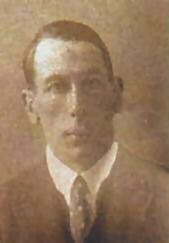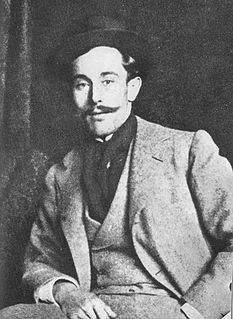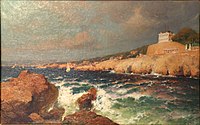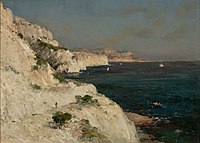
Louis Scutenaire was a poet, anarchist, surrealist and civil servant. Born Jean Émile Louis Scutenaire in Ollignies, Belgium, he died in Brussels.

Charles André Mare (1885–1932), or André-Charles Mare, was a French painter and textile designer, and co-founder of the Company of French Art in 1919. He was a designer of colorful textiles, and was one of the founders of the Art Deco movement.
Claude Le Baube (1919–2007) was a painter and sea captain.
Jean-Baptiste Lallemand (1716–1803) was a French artist born in Dijon. He was mainly a painter and draftsman of landscapes and genre works. He sometimes signed himself Lallemant or Allemanus. After a stay in Italy, he went to Paris and became a member of the Académie de Saint-Luc. He died in Paris.

Jean-Jacques-François Le Barbier was a writer, illustrator and painter of French history. By 1780 he was an official painter of the King of France.

Robert Antoine Pinchon was a French Post-Impressionist landscape painter of the Rouen School who was born and spent most of his life in France. He was consistent throughout his career in his dedication to painting landscapes en plein air. From the age of nineteen he worked in a Fauve style but never deviated into Cubism, and, unlike others, never found that Post-Impressionism did not fulfill his artistic needs. Claude Monet referred to him as "a surprising touch in the service of a surprising eye".

Jean Messagier was a French painter, sculptor, printmaker and poet. Jean Messagier had his first solo exhibition in Paris at Galerie Arc-en-Ciel in 1947. From 1945 to 1949 the artist worked under the influence of Pablo Picasso, André Masson, Paul Klee and François Desnoyer, his professor at École nationale supérieure des arts décoratifs in Paris. Messagier again was revealed to the public at an exhibition organized by Charles Estienne at the Galerie de Babylone in 1952, entitled "La Nouvelle École de Paris". The following year, Messagier deliberately broke away from his expressionistic form of Post-Cubism; his inspirations now focused on Jean Fautrier and Pierre Tal-Coat to develop a personal vision in which he renders "light...approached abstractly." Jean Messagier is often associated with Lyrical abstraction, Tachisme, Nuagisme, Art informel and paysagisme abstrait, though the artist himself had never accepted any labels, and had always refused the distinction between abstraction and figuration. From 1962 until the year of his death Jean Messagier exhibited in France and abroad, taking part in some major international events as a representative of new trends in French painting.

The Musée Cantini is a museum in Marseilles that has been open to the public since 1936. The museum specializes in modern art, especially paintings from the first half of the twentieth century.

Henri Clément Serveau, also known as Clément-Serveau, was a French painter, designer, engraver and illustrator. Clément-Serveau produced works in a realist manner early on, but soon became interested in the new movements. He was influenced by his friend Louis Marcoussis and experimented with Cubism, utilising geometric patterns to give the illusion of form and space. Later in his career he turned toward abstraction with a post-cubist stance. He designed banknotes for the Banque de France and produced large murals and participated in numerous French and international exhibitions.

Paul Albert Laurens was a French painter.

Simon Joseph Simon-Auguste was a French artist, known for his intimate paintings, mainly portraits, nudes and still lifes. His production is characterized by a calm, intimate feel, and the effective use of glaze.

Le Pont aux Anglais, soleil couchant is an oil painting created in 1905 by the French artist Robert Antoine Pinchon (1886–1943). Associated with the new generation of l'École de Rouen Pinchon executed this work in a Post-Impressionist style with a subdued Fauve or Neo-Impressionist palette of golden yellows and incandescent blues. The dynamic image of the train in Pinchon's painting is an homage to the emerging industrialized world.

Vincent Manago (1880–1936) was a French painter specialised on landscapes, marines and genre paintings of the Mediterranean coast of oriental style.

Jean Seignemartin was a French painter of the Lyon School.

Jean-Édouard Dargent, known as Yan' Dargent and in his later years Yann Dargent, was born in Saint-Servais on 15 October 1824 and died in Paris on 19 November 1899. He was a French painter and illustrator. Most of his paintings depicted Brittany.
Jean-Baptiste Jules Trayer was born in Paris in 1824 and died in 1909. He was a French painter. He signed his works "Jules Trayer".
Charles Léon Godeby, was a French painter who painted scenes in Brittany and North Africa.

Jacques Hérold was a prominent surrealist painter born in Piatra Neamț, Romania.

Alexandre Jean-Baptiste Brun was a French painter, a pupil of Alexandre Cabanel, Carolus-Duran and Félix Bracquemond. He is especially known for his many marine paintings and a collection of watercolors on dark wash representing orchids.

Henri-Horace Roland Delaporte was a French still life painter.























